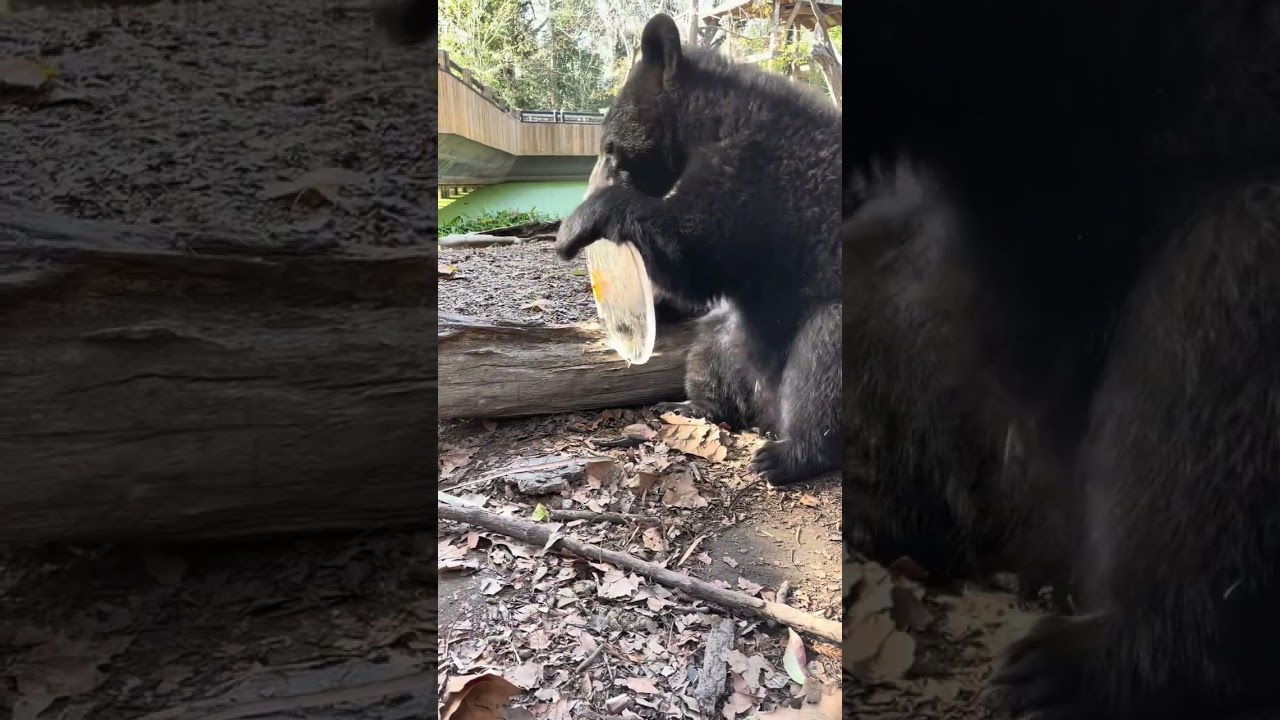– Behaviors and adaptability of American black bears
– The role of enrichment activities in the well-being of captive animals
– Interaction and relationships between different species in captivity
Picture this – a black bear ambles towards a glistening pond on a sun-drenched afternoon under the leafy canopy of an American forest. With precise, almost dainty steps, it dips its muzzle in for a soothing sip. This isn’t just any routine for the bear; it is a dance with the elements, a play of survival, instinct, and joy intertwined. But in our story, life has an amusing twist: black bear Sassafras finds ice treat not in her habitat but sourced from the most unsuspected of neighbors – a raccoon‘s water bowl.
Now, you might wonder, what could make this seemingly simple act worth noting? Well, my dear friend, that’s because, in such moments, we discover American black bears’ complexity and fascinating adaptability and the broader tapestry of animal behaviors and welfare, particularly within our zoological parks and sanctuaries.
American black bears, creatures of woodland whispers and twilight foraging, symbolize the wild’s heart. They roam extensively throughout North America, typically solitary and shy, and adapted to various habitats, including forests, swamps, and mountains. Their omnivorous diet sees them munching on anything from nuts and berries to small mammals and, on unusual occasions, goodies meant for other animals.
Captivity swings the doors wide open to an array of observations. Here, in a zoo or sanctuary’s controlled environment, black bears are given a unique opportunity to express behaviors that might not always be seen in the wild. Imagine Sassafras, our bear, with her ice treat. This scene is a stellar example of enrichment – a critical component of captive animal care to stimulate natural behaviors and ensure psychological well-being.
Enrichment comes in many forms: physical, sensory, food, cognitive, and social. Besides being a refreshing respite from the heat, an ice treat encourages the bear to forage and problem-solve much like she would in her natural environment. By fishing out the ice or licking it to get to the frozen food inside, Sassafras is doing more than just snacking; she’s exercising her mind and body in a constructive and sustaining way.
Bears often compete for resources in the wild, whether vying for prime fishing spots during salmon runs or staking claim to a berry-rich grove. These challenges are part of what makes them such adaptive and resilient animals. However, when food comes easy, it’s essential to remember that bears still require the mental stimulation their natural lifestyle would afford them.
Here lies the heart of wit in zookeeping: crafting scenarios where the unexpected becomes a bridge to natural behaviors. Perhaps the ice in Sassafras’ possession started as a simple cooling-off trick. Still, in a beat, it became an imitation of a frozen winter’s day treat or a representation of a swift stream’s offering encased in ice.
But now, let us peer behind the bear and glance at the raccoons. These ring-tailed rascals are another facet of North America’s wildlife, known for their wily intelligence and opportunistic diets. Who’s to say the water bowl wasn’t ‘borrowed’ in a moment of ingenuity by our bear friend? In the wild, raccoons are remarkable for adapting to urban environments, deftly turning over garbage cans and unlocking coon-proof latches. Both bears and raccoons share a resourceful spirit, thriving in environments using their wits and dexterous appendages.
Witnessing bears interacting with items from other animals is more than a simple curiosity. It’s an insight into animal intelligence and flexibility in behavior. Zoos and sanctuaries must constantly find ways to reflect the diverse and challenging realms these animals naturally navigate. The exchange of a raccoon’s water bowl for an ice treat becomes a potential launching point for prodding the cerebral nature of Sassafras.
Moreover, these instances can foster interspecies interactions. It’s a reminder that even if we see distinct boundaries between habitats in human-created spaces, animals’ lives are far more interwoven. A raccoon may stumble upon a bear in the woods, leading to a cautious retreat or an opportunistic watch from the trees. Though not always visible, these interactions underline the complex web of relationships in nature.
Maintaining these threads of connection in zoos and sanctuaries is pivotal. It isn’t merely about providing a habitat, but also about integrating opportunities for animals to experience the interconnectedness, they would feel in the wild. An ice treat, taken with the most innocent intentions, can be a puzzle piece in a curious black understanding of life’s tapestry. Zoo visitors are not just seeing creatures in exhibits when they watch these animals; they are learning about the nuances of behaviors, the importance of mental stimulation, and the interconnectedness of ecosystems. This knowledge fosters respect and compassion, driving conservation efforts and increasing awareness of the natural world.
Education is a natural byproduct of the attention zookeepers and caretakers put into their enrichment programs. Every opportunity for animals to engage in behavior that might make a visitor stop and ponder is an opportunity to spread knowledge and passion for wildlife conservation. It tells a story where the bear with her ice treat becomes an ambassador for her wild kin and their environments.
Through the fun and joy of watching Sassafras delight in her ice treat, one gains a profound appreciation for the delicate balance of our ecosystems and the remarkable adaptability of these majestic creatures. It serves as a reminder of the continuous need to innovate in captive animal care and our responsibility to protect and preserve the habitats these animals call home.
So the next time you see Sassafras or any wild creature engaged in a peculiar act, consider the story behind the spectacle. Remember ecosystems’ enrichment, intelligence, adaptability, and intricate dance. Smile, learn, and share, for every such interaction is a thread in the richly woven fabric of our living world.
*****
Source Description


